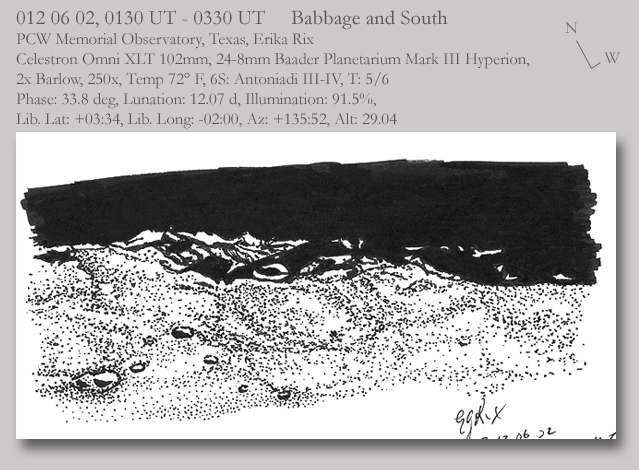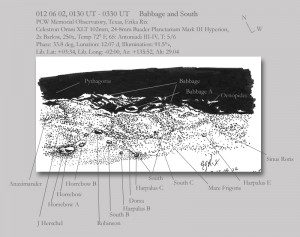
2012 06 02, 0130 UT – 0330 UT Babbage and South
PCW Memorial Observatory, Texas, Erika Rix
www.pcwobservatory.com
Celestron Omni XLT 102mm, 24-8mm Baader Planetarium Mark III Hyperion, 2x Barlow, 250x
Temp 72° F, 6S: Antoniadi III-IV, T: 5/6, Phase: 33.8 deg, Lunation: 12.07 d, Illumination: 91.5%
Lib. Lat: +03:34, Lib. Long: -02:00, Az: +135:52, Alt: 29.04
Eyepiece sketch on white acid-free card stock, black felt-tipped artists pens.
The eastern walls of impact crater Babbage formed dramatic streaks of thick shadow across its lava-filled floor. The highlighted areas of Pythagoras and Oenopides to either side of Babbage created slender chunks of light depicting the highest peaks of their rims. I was very tempted to sketch the entirety of the trio and would have most likely done so had I been using charcoal or chalk for media instead of a stippling technique.
Stippling is a very old and disciplined method of rendering the Moon, not to mention tedious. Done correctly, the results can be very accurate with magnificent observation records. I have a book of selenographer Harold Hill’s observations filled with his wonderful sketches, quite a few of them stippled or created with ink wash. http://www.amazon.com/Portfolio-Drawings-Practical-Astronomy-Handbooks/dp/0521381134 “A Portfolio of Lunar Drawings (Practical Astronomy Handbooks)” by Harold Hill. He carefully drew line sketches and used a tonal scale legend to depict density of shadows. Later, away from the scope, he would create a “finished” sketch with ink using his outlined eyepiece sketch as a guide. He stated (on page xvi), “One advantage of this system is that, provided the original drawing is conscientiously done, it is possible to prepare a satisfactory “finished” representation of what was seen two days, two weeks or even two years on without having to rely on that notoriously uncertain faculty – memory.”
By making a line drawing, it is possible to very quickly capture shadows, freezing the sketch in that moment. For this reason, I often find charcoal on white paper best to use 30 degrees or so from the terminator as it takes me longer to draw in the shadows with that medium. There are other options for capturing fast moving shadows. My friend, Rich Handy, introduced me to white chalk on black paper. Sketching the highlights can save quite a bit of time in a fast moving scene, such as shadows moving across the lunar surface as the terminator progresses. If you opt for black on white instead, you can still “freeze” the scene by concentrating on all the shadowed areas first and then work on the less pressing features.
It’s not the full proof, but what is really? An argument against redrawing the sketch away from the eyepiece is that there is only so much detail you can fit in a schematic line drawing. To recreate the drawing on a later date runs the risk of inadvertently adding more detail to the sketch than what you actually saw or simply remembering the details inaccurately because the notes and schematic sketch perhaps didn’t supply enough information.
On the flip side, how could a person draw a detailed sketch close to the terminator quickly enough to capture an accurate rendering because the fast shadow movement constantly altering the scene? I believe there’s no method that is without faults…yet both have great merits and will certainly make you a more conscientious visual observer as a result. Either way, it’s imperative that if you’re striving for accuracy true to your observation, you must make a dedicated and fastidious effort to sketch exactly what you see rather than enhancing the sketch to make it more pleasing to the eye.
I tend to struggle remembering details well enough from the time my eye leaves the eyepiece to the time it takes to looks down at the paper to sketch. I have more difficulty trying to recreate the scene that same night after packing up my gear, let alone the next day or days after the observation. My schematic sketches leave more to be desired as far as details are concerned, although I’m sure that like anything else, practice makes perfect as the saying goes. I have been playing around with stippling at the eyepiece using felt-tipped pens. The results don’t hold a candle to the likes of experienced sketchers such as Harold Hill who use that technique but I’m improving and am enjoying the experience.
I outline the brightest areas beyond the terminator first and then fill in the blackness. The lunar features almost create themselves as a result. The black shadows within craters on the lunar disk are next and then the darker tones on the surface, both shadows and darker albedo tones. The brightest areas on the surface appear by default and can be sparingly stippled as needed.
The most difficult part of the process for me is eyestrain, especially as I’m far sighted. All those dots tend to run together after awhile. (So far, I’ve rarely had the need to use my reading glasses while sketching at the eyepiece. I hope that time doesn’t come.) I also tend to be heavy handed with the pressure I use on the pens, which result in a busy sketch where the features are difficult to digest. My dots aren’t uniformed and I feel the sketch would have been much improved had I given more time for proper spacing. The sketch lacks the very fine, delicate stippled effect of the masters for that technique, but I feel fairly confident that the scene was captured as accurately as my skills and stippling experience allowed.
Walled plain South was very difficult for more me as it mainly consisted of tonal ranges instead of defined boundaries. Looking at my sketch now, I could have done a better job at not filling in as many dots for the lighter, higher areas that haven’t been completely covered with lava.


Erika,
An excellent capture and good target choice for this method of rendering.
There are not many that can sketch this way; you have mastered this technique.
Frank 🙂
Erika,
Thank you for the information about the stippling technique, I tried it for other compositions, but never astronomical & its been many years. It is a challenge as you said, but your rendering is very eye catching, detailed & dramatic. I plan to give it a try after being inspired by your drawing. Your point about not being able to reproduce what you see at the EP even a moment after the eye leaves the target hits home! Glad its not just old age!
Warmest Aloha,
Thia (Cindy)
Hello Erika,
That is an excellent sketch. The combination of solid shadows and stippling has worked very well.
Best regards,
-Ivan